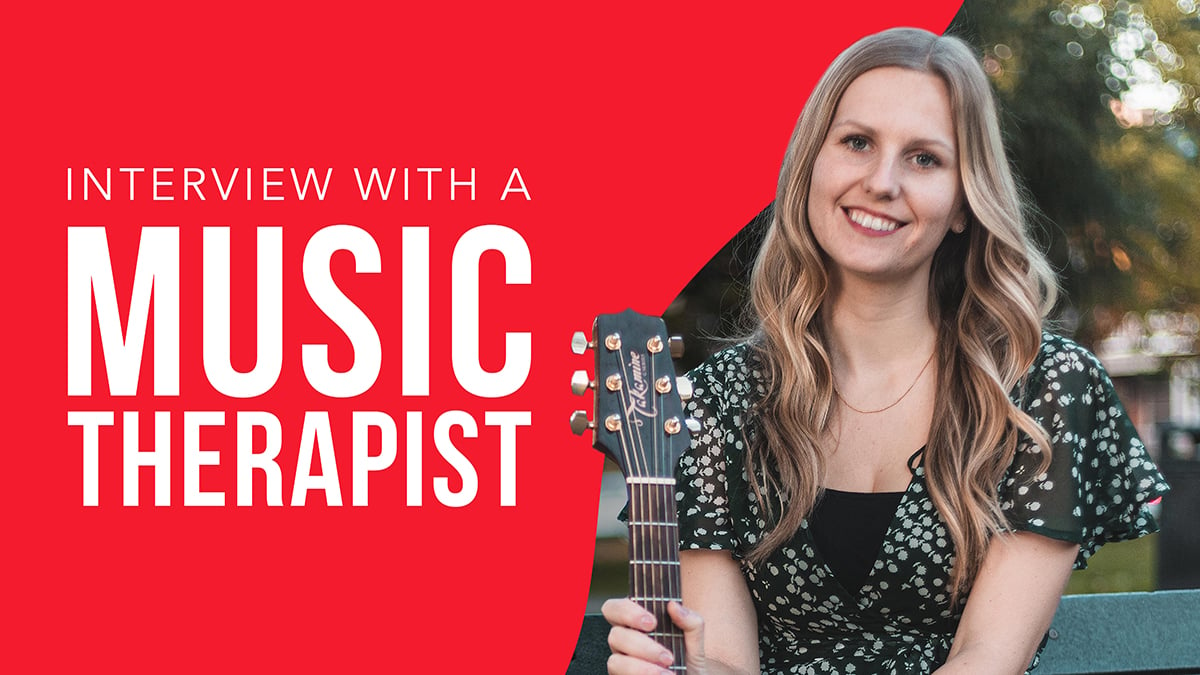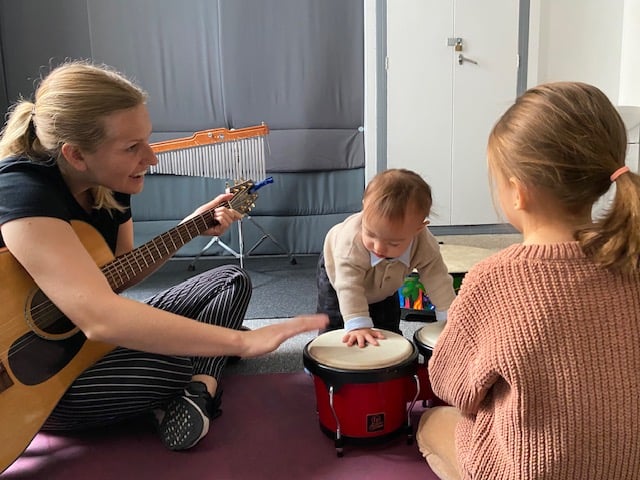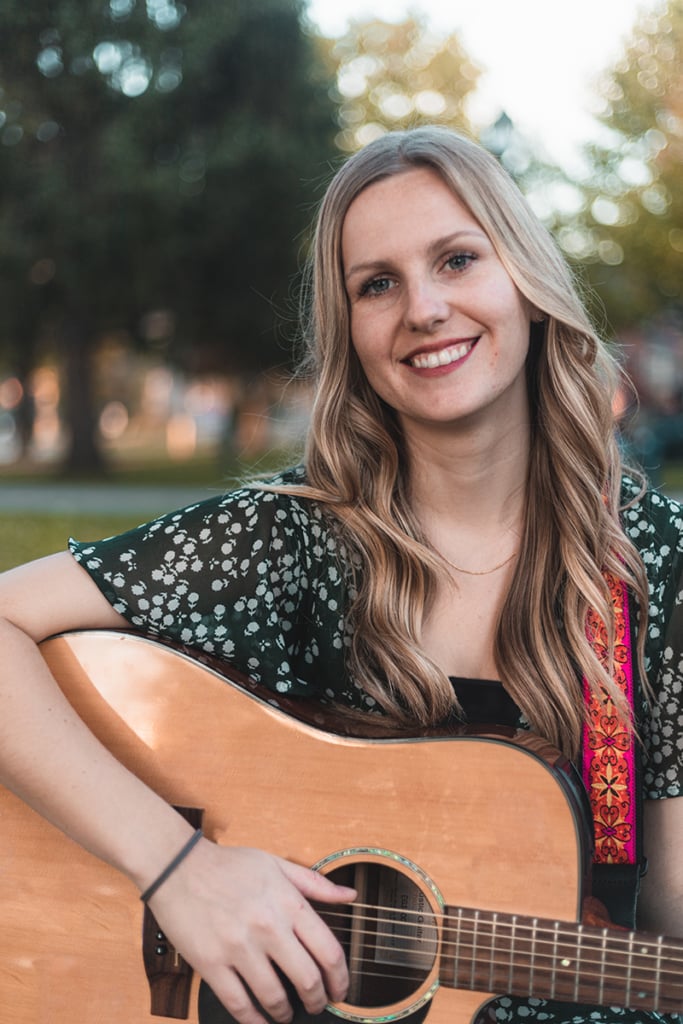
Have you ever wondered how to become a music therapist? It sounds like an incredibly rewarding job: improve people’s lives with what you’re passionate about!
If you’re curious about whether this is the right job for you, you’ve come to the right place. Here’s a lightly edited interview with Olivia Maveal, an accredited music therapist (MT-BC, NMT) and owner of Summit Music Therapy.
Table of Contents:
Get exclusive interviews, fascinating articles, and inspiring lessons delivered straight to your inbox. Unsubscribe at any time.
This is a great question and one that I receive often. The goal of music therapy varies based on each client’s individual needs and goal areas. Music therapy is a clinical process that involves assessments, treatment plans, and progress tracking. During the assessment process, we look at a client’s personal strengths and potential areas for improvement. This guides us during the treatment planning phase, where we can use this data to design goals and objectives that are unique to each client.
Decrease Isolation
For example, for an individual with dementia who spends a lot of time in their room, a potential goal may be to decrease feelings of isolation. This may be achieved through consistent group music therapy sessions, in which residents are encouraged to socialize with community members through interactive musical experiences.
This may involve improvising on instruments, participating in a drum circle, or singing along with familiar songs that evoke group discussions. For this population, music therapy becomes a valuable tool to encourage socialization, increase cognitive function, and support mental health.
Improve Emotional Regulation
To support a client struggling with emotional regulation, a potential goal area may center around developing positive coping strategies. Within this context, songwriting may be a potential intervention, allowing clients to explore strategies that can extend beyond the therapy room. Collaborative songwriting can facilitate meaningful conversations between the client and therapist around managing big emotions. For instance, imagine a songwriting session where the client and therapist come together to co-create a song, filling in the lyrics to a pre-existing song structure. This process allows challenging conversations to feel more approachable when framed within the enjoyable and motivational nature of music.
Another music therapy intervention for emotional regulation encompasses the use of breathing songs. These are compositions sung to encourage deep breathing and mindfulness guided by the gentle strumming of a guitar, or the soft and steady beat of a drum.
> 14 Benefits of Playing Piano
Facilitate Communication

A lot can be communicated through music that we can’t express with words. Within music therapy, a client who is non-speaking can create a musical dialogue with the therapist in which they can exchange ideas and build mutual trust. This may involve a variety of instruments, such as guitars, ukuleles, piano, drums, handheld percussive instruments, xylophones, chimes, ocean drums, etc. If the goal is to increase communication, the client and therapist may focus on alternative methods of expressing their needs, such as using musical cueing or decision-making supported by visual resources like picto cards. Music can be a powerful medium for fostering communication and self-expression.
Through the system of documentation and progress tracking, we establish an ongoing process to evaluate a client’s goals and objectives. Music therapists conduct periodic evaluations, often quarterly or bi-annually, in which we re-evaluate the treatment plan and determine if any modifications or adjustments are necessary. This ensures that sessions remain responsive to the evolving goals and needs of each client.

A lot can be communicated through music that we can’t express with words. Within music therapy, a client who is non-speaking can create a musical dialogue with the therapist in which they can exchange ideas and build mutual trust.
Olivia Maveal
Absolutely. For clients with limited self-expression or emotional challenges, songwriting interventions can be an incredible tool for self-growth and emotional expression. Music therapists may help their clients ease into this process by starting with simple songwriting, including rewriting the lyrics to familiar songs.
Within music therapy, there are various evidence-based techniques designed for specific client populations. These techniques use specific elements of music (i.e. rhythm, tempo, melody, dynamics) to influence and change non-musical brain function and behavior.
One example is a Neurologic Music Therapy technique involving motor function that has been used widely for individuals affected by a stroke or Parkinson’s. It is called Rhythmic Auditory Stimulation (RAS), and it is used in the rehabilitation of movements that are biologically rhythmical, such as gait (a person’s manner of walking). RAS can be used as an immediate entrainment stimulus providing rhythmic cues during movement. In other words, the music can help an individual get into a rhythm/pattern of movement because it gives hints about how to move in a coordinated way (similar to when the beat of a song encourages your steady rhythm when dancing). It can also be used as a facilitating stimulus for a client to achieve more functional gait patterns, through training and practice walking in alignment with a rhythmic stimulus.
Another Neurologic Music Therapy technique used is Melodic Intonation Therapy (MIT). This rehabilitative technique was developed for clients with expressive aphasia. This technique takes advantage of an intriguing aspect, which is these individual’s unimpaired ability to sing. MIT uses sung and chanted melodies that mimic the natural patterns of speech intonation, with the goal of increasing the linguistic aspects of spoken language. For example, a therapist and client may work on functional phrases such as “I am thirsty” or “I need to use the bathroom”. MIT incorporates melodic and rhythmic components into these functional phrases and then involves a gradual fading of the musical elements to aim for more natural spoken phrases. This technique holds significant value for clients seeking to express their needs and potentially regain a degree of independence in their communication.
For clients with limited self-expression or emotional challenges, songwriting interventions can be an incredible tool for self-growth and emotional expression.
Olivia Maveal
For more information on Neurologic Music Therapy and the two techniques mentioned above, visit the Academy of Neurologic Music Therapy.
With all of this in mind, I will reiterate that music therapy is a creative therapy, so there is lots of room for creativity and adaptation based on the unique needs of our clients.
I believe that it is very important to have a passion for music and a deep understanding of its transformative nature. For myself, a large part of this understanding comes from my own personal journey with music, and the healing role that it has played in my own health and well-being. I think that for music therapists, it’s important to maintain the personal connection we have with music throughout our careers to remain invested in the work. Music therapists should be compassionate and have a desire to support others and to walk alongside them on their journey.
Musical proficiency is important to providing high-quality sessions that are beneficial to your clients. These skills can be developed within the music therapy education programs, as there are required courses to improve your skills on piano, guitar, and voice before graduating and becoming an Accredited Music Therapist (MTA).
I have met a wide variety of personalities working in the field of music therapy, and I believe that each therapist’s unique personality traits, skills, and quirks naturally become a part of their work.
Note: Olivia Maveal works in Montreal, Québec and earned her credential in Ontario. Accreditation requirements in your area may be different. Please research requirements specific to your individual situation.
Becoming a music therapist involves a combination of education, clinical training, and board certification. You must complete a university music therapy program, which involves coursework in music, psychology, and music therapy skills. Each music therapist must complete a 1000-hour internship to gain practical experience under the supervision of a board-certified music therapist (MTA). Upon completing your internship, you must then write a certification exam through the Certification Board of Music Therapists (CBMT) to gain your accreditation. With this accreditation, you can practice under the title of an accredited music therapist (MTA), and you must complete ongoing professional development and education requirements to maintain your certification.

I will reiterate that music therapy is a creative therapy, so there is lots of room for creativity and adaptation based on the unique needs of our clients.
Olivia Maveal
I would say a big challenge about being a music therapist in Canada is the lack of insurance coverage for services. This creates a landscape in which many clients have to pay out of pocket for services and causes a lack of accessibility for many individuals to receive music therapy.
Music therapy has a large focus on the therapeutic relationship between the client and therapist, and the collaborative process is linked to the effectiveness of music therapy. However, of course there are ways we can use music as a therapeutic tool in our own lives.
Breathing is an intrinsic part of singing and music-making. Research has shown that deep breathing can lower our heart rate and blood pressure. Box breathing along with meditative music can be an excellent strategy. Here is an example.
In a study that focuses on relaxation, the song “Weightless” by Marconi Union was shown to lower heart rate and decrease respiration rate. The findings from this study highlight significant changes in mental relaxation and stress levels linked with active listening to this song.
Music can change the world because it can change people.
Bono (one of Olivia’s favorite music quotes)
We hope you enjoyed this interview with Olivia Maveal! Check out more music interviews:
The best way to learn piano is with real teachers, but not everyone has the time and money for a private instructor. At Pianote, you can get real feedback from real experts…all from the comfort of your own home. Explore our Method and community yourself with a free 7-day trial.
TRY PIANOTE FOR 7 DAYSCharmaine Li is a Vancouver writer who has played piano for over 20 years. She holds an Associate diploma (ARCT) from the Royal Conservatory of Music and loves writing about the ways in which music—and music learning—affects the human experience. Charmaine manages The Note. Learn more about Charmaine here.


By signing up you’ll also receive our ongoing free lessons and special offers. Don’t worry, we value your privacy and you can unsubscribe at any time.
We use cookies for traffic data and advertising. Cookie Policy »